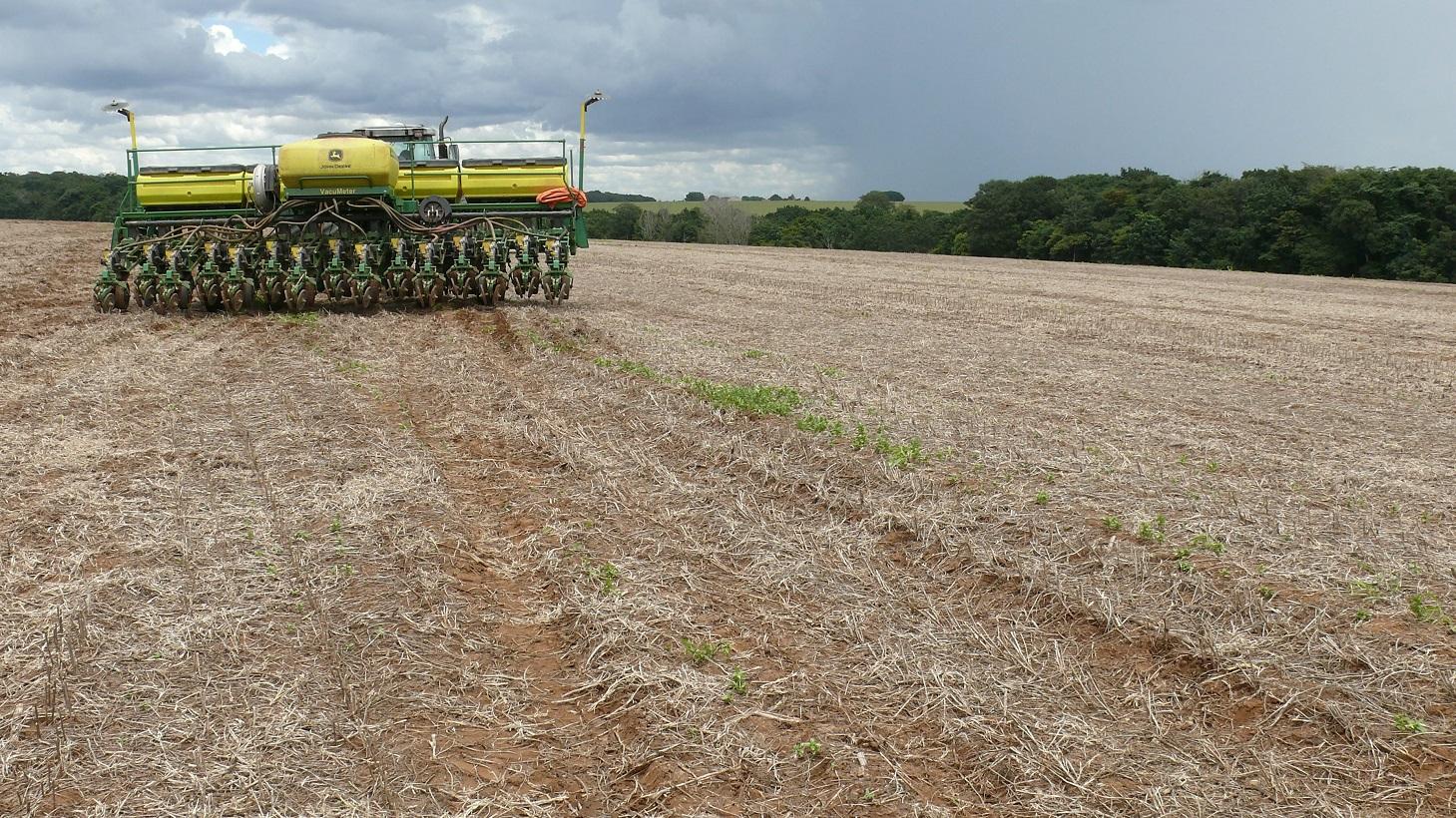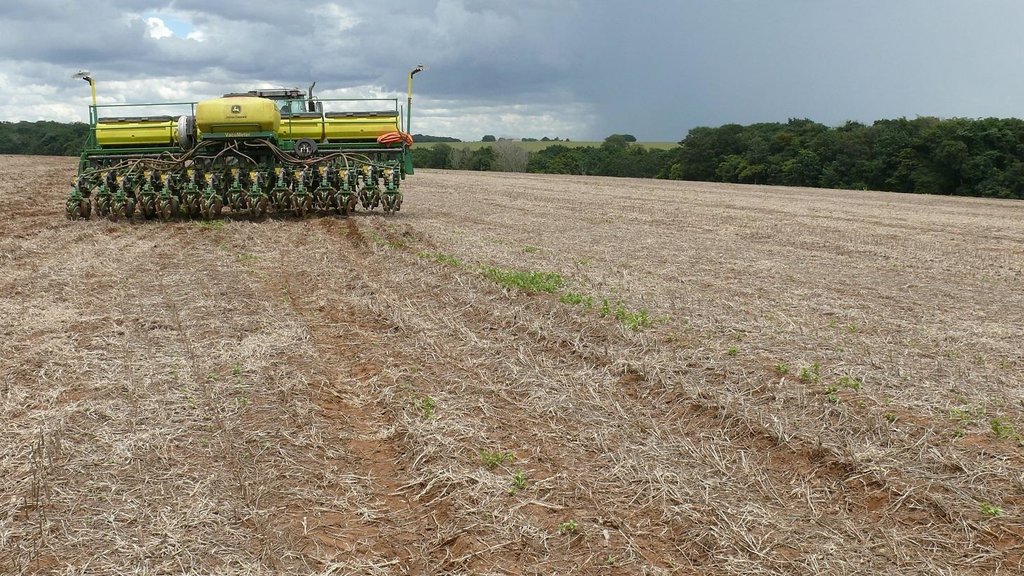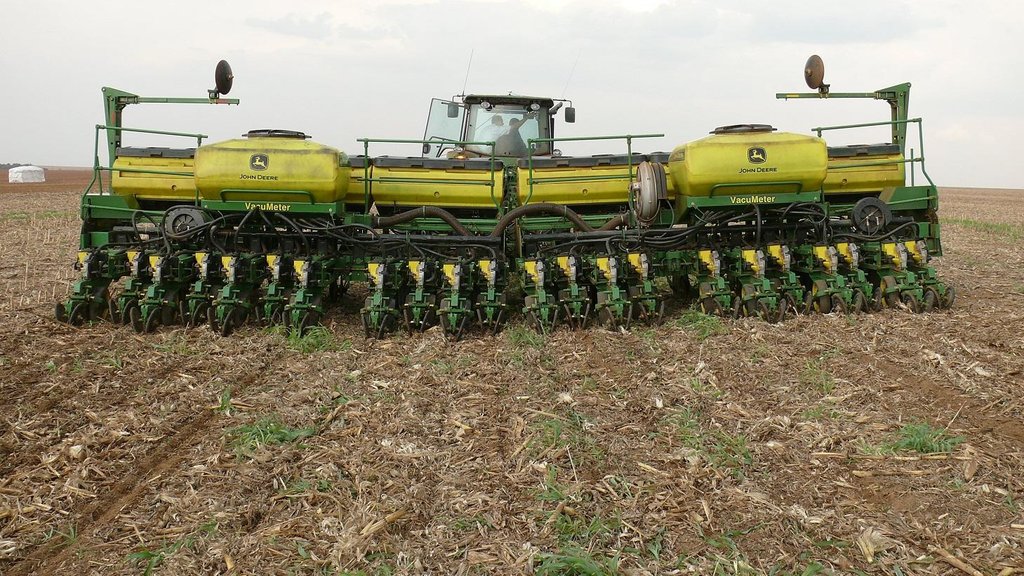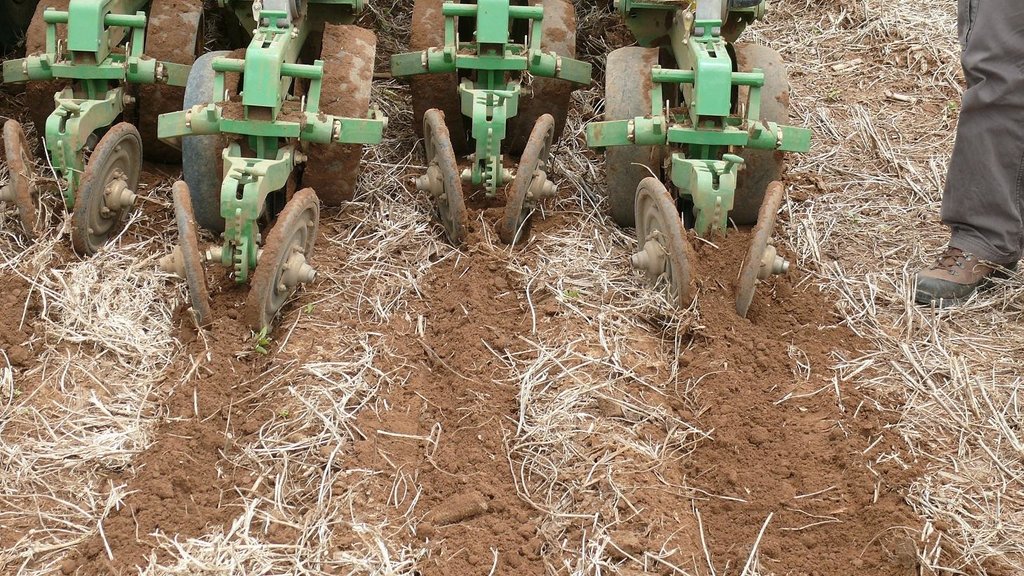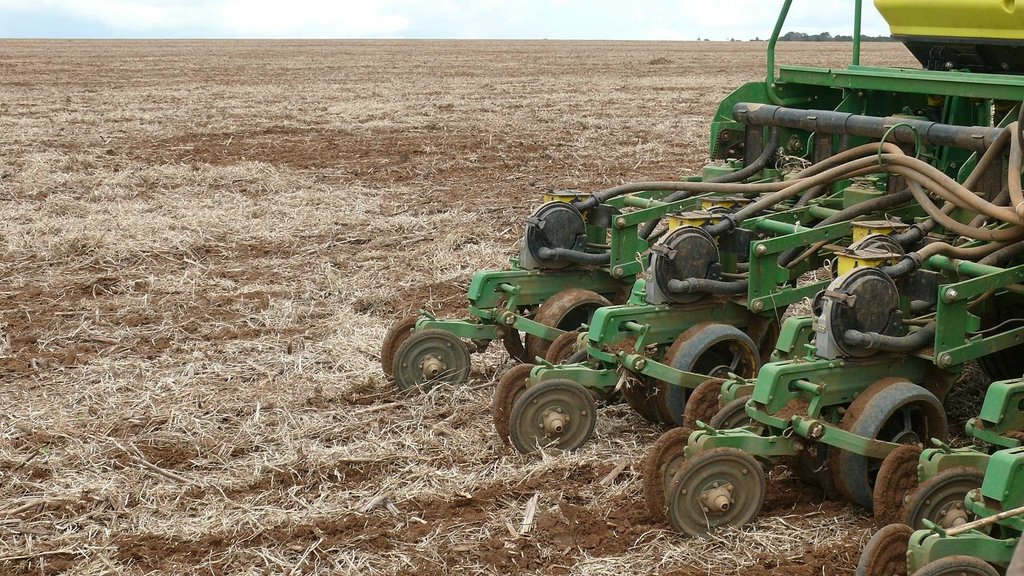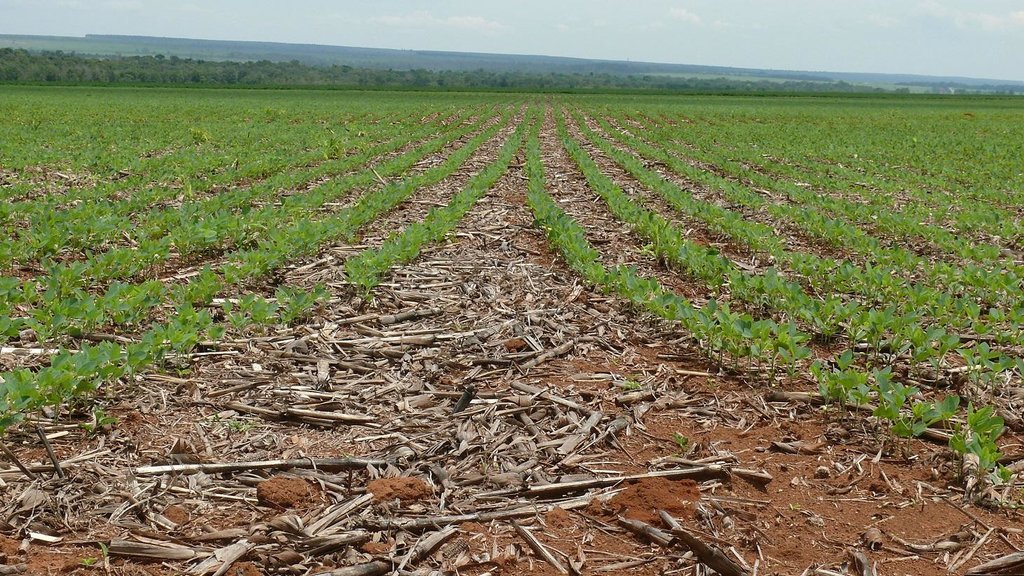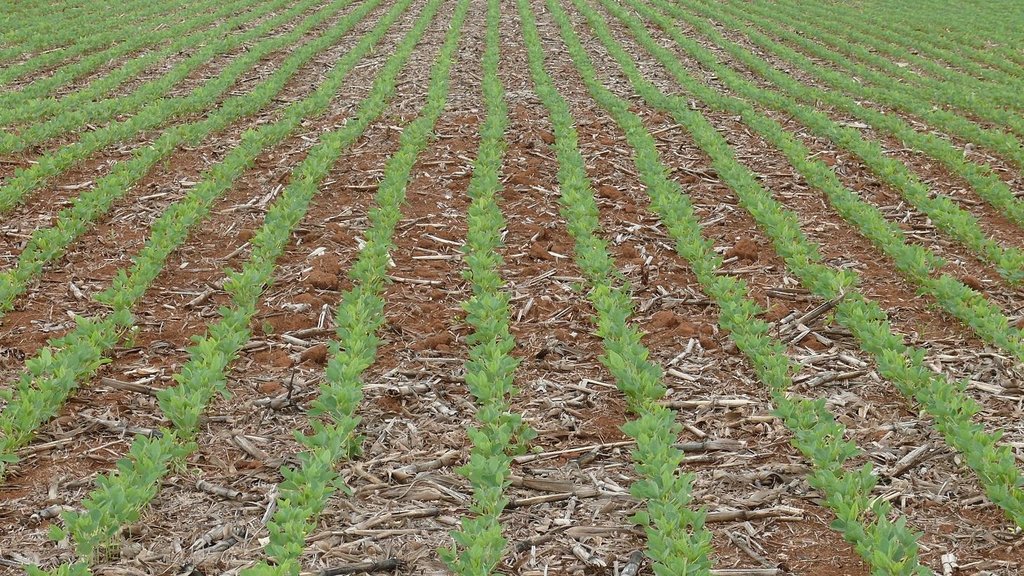Minimum tillage [巴西]
- 创建:
- 更新:
- 编制者: Stefan Hohnwald
- 编辑者: –
- 审查者: Alexandra Gavilano
Plantio direto
technologies_1270 - 巴西
查看章节
全部展开 全部收起1. 一般信息
1.2 参与该技术评估和文件编制的资源人员和机构的联系方式
SLM专业人员:
Schindewolf Marcus
+49 3731 390
Technische Universität Bergakademie Freiberg
Akademiestraße 6, 09599 Freiberg, Germany
德国
有助于对技术进行记录/评估的机构名称(如相关)
Technische Universität Bergakademie Freiberg - 德国有助于对技术进行记录/评估的机构名称(如相关)
Georg August Universität Göttingen (Georg August Universität Göttingen) - 德国1.3 关于使用通过WOCAT记录的数据的条件
(现场)数据是什么时候汇编的?:
20/07/2015
编制者和关键资源人员接受有关使用通过WOCAT记录数据的条件。:
是
2. SLM技术的说明
2.1 技术简介
技术定义:
Seed of maize and soy are planted directly into the soil with a minimum previous tillage impact.
2.2 技术的详细说明
说明:
After harvesting stubbles of maize or soy remain on site. When the planting season started the soil is opened by rolling discs pulled by a tractor. The seeds are directly put into the open soil which is compacted afterwards with rolling wheels of the same machine.
Purpose of the Technology: With minimum tillage practices tilling and seeding operations could be implemented fast and very efficient. The high power of impact allows the cultivation of large fields in short time, especially if small windows of wet initial conditions need to be used. The purpose is to avoid deep plowing of the soils that would need much higher energy and costs and would lead to typical serious erosion problems in the tropics.
Establishment / maintenance activities and inputs: The technology was implemented in the area since approximately 15 years. High technological standard of tillage tools, tractors and service is needed. Since the whole farm system has changed, farmer need special knowledge in no-till measures especially with regard to pest management.
Natural / human environment: The region belongs to the semi-humid tropics and to the cerrado biome in the centre of the South American continent. Natural vegetation has been deforested some 20-40 year ago and was shifted to soy bean fields, pastures, corn and sugar cane fields.
2.3 技术照片
2.5 已应用该技术的、本评估所涵盖的国家/地区/地点
国家:
巴西
区域/州/省:
Mato Grosso
有关地点的进一步说明:
Campo Verde, Primavera do Leste
注释:
Boundary points of the Technology area: Flat cerrado biome of Brazil
Map
×2.6 实施日期
如果不知道确切的年份,请说明大概的日期:
- 10-50年前
2.7 技术介绍
详细说明该技术是如何引入的:
- 通过土地使用者的创新
3. SLM技术的分类
3.2 应用该技术的当前土地利用类型

农田
- 一年一作
主要农作物(经济作物及粮食作物):
Major cash crop annual cropping:
Major cash crop mixed cropping: Corn and cotton

森林/林地
产品和服务:
- 木材
- 薪材
- 自然保持/保护
注释:
Major land use problems (compiler’s opinion): biodiversity loss, water pollution, soil erosion
Major land use problems (land users’ perception): unpredictable weather, unpredictable world market prices, climate change
Forest products and services: timber, fuelwood, nature conservation / protection
Type of cropping system and major crops comments: Sometimes Pearl millet is planted as an inter-crop.
3.3 有关土地利用的更多信息
注释:
Water supply: rainfed
每年的生长季节数:
- 2
具体说明:
Longest growing period in days: 150 Longest growing period from month to month: September-January Second longest growing period in days: 100 Second longest growing period from month to month: January-July
3.4 该技术所属的SLM组
- 最小的土壤扰动
3.5 技术传播
具体说明该技术的分布:
- 均匀地分布在一个区域
如果该技术均匀地分布在一个区域上,请注明覆盖的大致区域。:
- > 10,000 平方千米
注释:
The area in which the SLM technology is applied is much bigger and can be found also in other states of Brazil that is located in the cerrado biome.
3.6 包含该技术的可持续土地管理措施

农艺措施
- A1:植被和土壤覆盖层
- A3:土壤表面处理

结构措施
- S1:阶地

管理措施
- M1:改变土地使用类型
- M2:改变管理/强度级别
- M6:废物管理(回收、再利用或减少)
注释:
Main measures: agronomic measures, structural measures, management measures
Type of agronomic measures: better crop cover, mixed cropping / intercropping, cover cropping, legume inter-planting, manure / compost / residues, mineral (inorganic) fertilizers, zero tillage / no-till, minimum tillage
3.7 该技术强调的主要土地退化类型

土壤水蚀
- Wt:表土流失/地表侵蚀
注释:
Main type of degradation addressed: Wt: loss of topsoil / surface erosion
Main causes of degradation: soil management, deforestation / removal of natural vegetation (incl. forest fires), Heavy / extreme rainfall (intensity/amounts), droughts
Secondary causes of degradation: crop management (annual, perennial, tree/shrub), change of seasonal rainfall, wind storms / dust storms, floods
3.8 防止、减少或恢复土地退化
注释:
Main goals: prevention of land degradation
Secondary goals: mitigation / reduction of land degradation,
Third goal: rehabilitation / reclamation of denuded land
4. 技术规范、实施活动、投入和成本
4.2 技术规范/技术图纸说明
Technical knowledge required for field staff / advisors: high
Technical knowledge required for land users: high
Main technical functions: control of dispersed runoff: retain / trap, control of dispersed runoff: impede / retard, control of concentrated runoff: retain / trap, control of concentrated runoff: impede / retard, improvement of ground cover, increase in nutrient availability (supply, recycling,…), increase / maintain water stored in soil
Secondary technical functions: control of raindrop splash, reduction of slope angle, reduction of slope length, increase of surface roughness, improvement of surface structure (crusting, sealing), improvement of topsoil structure (compaction), improvement of subsoil structure (hardpan), increase in organic matter, increase of infiltration, increase of groundwater level / recharge of groundwater, water harvesting / increase water supply, water spreading, increase of biomass (quantity)
Better crop cover
Material/ species: stubbles
Mixed cropping / intercropping
Material/ species: safrinha
Cover cropping
Material/ species: stubbles
Terrace: backward sloping
Vertical interval between structures (m): 2
Spacing between structures (m): 50
Bund/ bank: level
Vertical interval between structures (m): 0.5
Spacing between structures (m): 50
4.3 有关投入和成本计算的一般信息
其它/国家货币(具体说明):
Real Brasileiro
注明美元与当地货币的汇率(如相关):1美元=:
3.06
注明雇用劳工的每日平均工资成本:
15.00
4.4 技术建立活动
| 活动 | 措施类型 | 时间 | |
|---|---|---|---|
| 1. | Bulldozing | 结构性的 | dry season |
4.5 技术建立所需要的费用和投入
| 对投入进行具体说明 | 单位 | 数量 | 单位成本 | 每项投入的总成本 | 土地使用者承担的成本% | |
|---|---|---|---|---|---|---|
| 劳动力 | Bulldozing | ha | 1.0 | 3000.0 | 3000.0 | |
| 技术建立所需总成本 | 3000.0 | |||||
4.6 维护/经常性活动
| 活动 | 措施类型 | 时间/频率 | |
|---|---|---|---|
| 1. | reparation | 农业学的 | yearly |
4.8 影响成本的最重要因素
描述影响成本的最决定性因素:
Costs are determined by the enormous field size and the soil type
5. 自然和人文环境
5.1 气候
年降雨量
- < 250毫米
- 251-500毫米
- 501-750毫米
- 751-1,000毫米
- 1,001-1,500毫米
- 1,501-2,000毫米
- 2,001-3,000毫米
- 3,001-4,000毫米
- > 4,000毫米
有关降雨的规范/注释:
September-April
农业气候带
- 半湿润
Thermal climate class: tropics. 25.6
5.2 地形
平均坡度:
- 水平(0-2%)
- 缓降(3-5%)
- 平缓(6-10%)
- 滚坡(11-15%)
- 崎岖(16-30%)
- 陡峭(31-60%)
- 非常陡峭(>60%)
地形:
- 高原/平原
- 山脊
- 山坡
- 山地斜坡
- 麓坡
- 谷底
垂直分布带:
- 0-100 m a.s.l.
- 101-500 m a.s.l.
- 501-1,000 m a.s.l.
- 1,001-1,500 m a.s.l.
- 1,501-2,000 m a.s.l.
- 2,001-2,500 m a.s.l.
- 2,501-3,000 m a.s.l.
- 3,001-4,000 m a.s.l.
- > 4,000 m a.s.l.
关于地形的注释和进一步规范:
Altitudinal zone: 501-1000 m a.s.l. (630 m)
5.3 土壤
平均土层深度:
- 非常浅(0-20厘米)
- 浅(21-50厘米)
- 中等深度(51-80厘米)
- 深(81-120厘米)
- 非常深(> 120厘米)
土壤质地(表土):
- 粗粒/轻(砂质)
表土有机质:
- 中(1-3%)
- 低(<1%)
如有可能,附上完整的土壤描述或具体说明可用的信息,例如土壤类型、土壤酸碱度、阳离子交换能力、氮、盐度等。:
Soil fertility: Low
Soil drainage/infiltration: Good
Soil water storage capacity: Very low
5.4 水资源可用性和质量
地下水位表:
5-50米
地表水的可用性:
中等
水质(未处理):
仅供农业使用(灌溉)
5.5 生物多样性
物种多样性:
- 高
5.6 应用该技术的土地使用者的特征
生产系统的市场定位:
- 商业/市场
非农收入:
- 收入的10-50%
相对财富水平:
- 丰富
- 非常丰富
个人或集体:
- 个人/家庭
机械化水平:
- 机械化/电动
性别:
- 男人
说明土地使用者的其他有关特征:
Land users applying the Technology are mainly Leaders / privileged
Population density: < 10 persons/km2
Annual population growth: 3% - 4%
5.7 应用该技术的土地使用者拥有或租用的平均土地面积
- < 0.5 公顷
- 0.5-1 公顷
- 1-2 公顷
- 2-5公顷
- 5-15公顷
- 15-50公顷
- 50-100公顷
- 100-500公顷
- 500-1,000公顷
- 1,000-10,000公顷
- > 10,000公顷
这被认为是小规模、中规模还是大规模的(参照当地实际情况)?:
- 大规模的
5.8 土地所有权、土地使用权和水使用权
土地所有权:
- 公司
土地使用权:
- 个人
用水权:
- 个人
5.9 进入服务和基础设施的通道
健康:
- 贫瘠
- 适度的
- 好
教育:
- 贫瘠
- 适度的
- 好
技术援助:
- 贫瘠
- 适度的
- 好
就业(例如非农):
- 贫瘠
- 适度的
- 好
市场:
- 贫瘠
- 适度的
- 好
能源:
- 贫瘠
- 适度的
- 好
道路和交通:
- 贫瘠
- 适度的
- 好
饮用水和卫生设施:
- 贫瘠
- 适度的
- 好
金融服务:
- 贫瘠
- 适度的
- 好
6. 影响和结论性说明
6.1 该技术的现场影响
社会经济效应
生产
作物生产
生产区域
土地管理
能源生产
收入和成本
农业投入费用
社会文化影响
冲突缓解
生态影响
水循环/径流
水量
水质
地表径流
多余水的排放
地下水位/含水层
蒸发
土壤
土壤水分
土壤覆盖层
土壤流失
土壤压实
养分循环/补给
土壤有机物/地下C
生物多样性:植被、动物
生物量/地上C
减少气候和灾害风险
碳和温室气体的排放
风速
6.2 该技术的场外影响已经显现
水资源可用性
旱季稳定可靠的水流
下游洪水
风力搬运沉积物
6.3 技术对渐变气候以及与气候相关的极端情况/灾害的暴露和敏感性(土地使用者认为的极端情况/灾害)
渐变气候
渐变气候
| 季节 | 气候变化/极端天气的类型 | 该技术是如何应对的? | |
|---|---|---|---|
| 年温度 | 增加 | 不好 |
气候有关的极端情况(灾害)
气象灾害
| 该技术是如何应对的? | |
|---|---|
| 局地暴雨 | 不好 |
| 局地风暴 | 未知 |
气候灾害
| 该技术是如何应对的? | |
|---|---|
| 干旱 | 不好 |
水文灾害
| 该技术是如何应对的? | |
|---|---|
| 比较和缓的(河道)洪水 | 不好 |
其他气候相关的后果
其他气候相关的后果
| 该技术是如何应对的? | |
|---|---|
| 缩短生长期 | 不好 |
6.4 成本效益分析
技术收益与技术建立成本相比如何(从土地使用者的角度看)?
短期回报:
消极
长期回报:
稍微积极
技术收益与技术维护成本/经常性成本相比如何(从土地使用者的角度看)?
短期回报:
中性/平衡
长期回报:
稍微积极
6.5 技术采用
在所有采用这项技术的人当中,有多少人是自发地采用该技术,即未获得任何物质奖励/付款?:
- 90-100%
注释:
90% of land user families have adopted the Technology without any external material support
There is a moderate trend towards spontaneous adoption of the Technology
6.7 该技术的优点/长处/机会
| 编制者或其他关键资源人员认为的长处/优势/机会 |
|---|
| The no-tillage technology reduced soil erosion by water and helps to minimize carbon release into the atmosphere. It reduces management costs in the long run. |
6.8 技术的弱点/缺点/风险及其克服方法
| 编制者或其他关键资源人员认为的弱点/缺点/风险 | 如何克服它们? |
|---|---|
| No tillage is a high-input technology that needs some expensive investments in the beginning. |
链接和模块
全部展开 全部收起链接
无链接
模块
无模块


